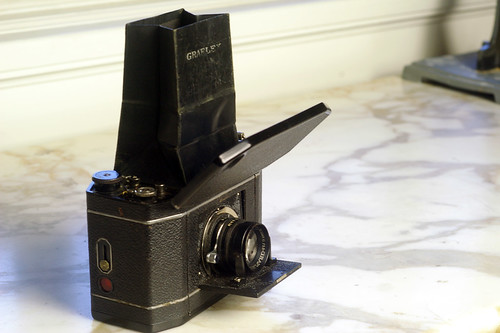National Graflex

|
| National Graflex Series 2 image by Nesster (Image rights) |
The National Graflex is a compact SLR camera made by Graflex from 1933. It makes 10 exposures 2¼×2½ inches on 120 rollfilm. There are two models, Series I 1933-35 and Series II 1934-41.[1] It has a focal-plane shutter with a top speed of 1/500s and a Bausch & Lomb Tessar f/3.5 75mm lens.
Overview
The National Graflex is an odd camera. It is the first prosumer 6x7, “Ideal Format” SLR camera, from an American camera builder. Compared to other American made cameras of the 1930s, it was a much more sophisticated design than anything else on the consumer market. Yet for being such a forward looking product, it is one of the more obscure products of the Graflex catalog. Perhaps attributable to failures in marketing, timing, or user experience, the National Graflex never was a resounding success for Graflex. Instead of becoming the first in a lineage of great cameras, like the Exakta, Leica, or Rolleicord, it is relegated to being a footnote in camera history (and the last of the short lineage of dedicated rollfilm Graflex SLRs).
The camera has a folding leather viewfinder hood with a built-in focusing magnifier and built-in analog exposure calculator for Kodak Verichrome film. It has a top shutter speed of 1/500s and f/3.5 Tessar lens, both reasonably fast for a consumer oriented camera of the 1930s. Additionally it uses 120 film instead of the 620 film common in more consumer cameras of the period.
However, in contrast to these desirable traits the camera has a few shortcomings. The viewfinder can be difficult to view through while stopped down, and is sometimes dim when fully open. It has a control scheme that is not intuitive and takes some practice and patience to get used to. There is no provision for flash synchronization. Advancing film via the winding knob and tensioning the shutter require some force to set, which may be difficult for some users. The horseshoe clip lens mount can be fiddly and difficult to mount in a hurry (though most other cameras used screw mounts at the time, which were not much better).
Despite this, when working within its quirks and limitations, the National Graflex can perform admirably, and produce excellent results, particularly with modern faster films.
Series I
The National Graflex Series I was produced from 1933-35. It looks almost identical to the later Series II, however, its horseshoe clip mount lens is not interchangeable with the Series II, and cannot accept the 140mm telephoto.
Series II
The National Graflex Series II was produced from 1934-41. While practically identical to the Series I, it has several minor improvements. The ruby window gains a small toggle to cover the film once the frame counter has been set. The top plate gains two threaded inserts for cable releases. One on the left, for instantaneous exposures; the other on the right, for bulb exposures. Additionally, the Series II has a modified horseshoe clip lens mount, which permits the use of a B&L 140mm telephoto lens.
Operating
The National Graflex control scheme is very different from later compact SLRs. Like its larger Graflex siblings, each operation requires a distinct action. The mirror must be set to focus the lens, and reset after each exposure, via a small thumb lever. The shutter must be wound before each exposure, and the shutter speed must be selected after winding (by pulling up and twisting to select). The aperture must be stopped down after focusing wide open. Film must be wound after each exposure with little provision for double exposure prevention. All of these controls must be adjusted before taking an exposure. Care must be taken when operating the camera to assure proper exposure, and to avoid damaging the camera. It is recommended that one read the manual and familiarize themselves with the controls before attempting to use the camera.
Warning
To avoid damage to the camera, it is best to heed the following instructions. When closing the lens door: the mirror should be set to the focusing position. Turn the lens focus lever to the lowest position, and swing door up until it locks closed. The shutter should not be wound when the camera door is folded in, to release the shutter without tripping the mirror, pull the the bulb lever towards the rear of the camera. When closing the lid: be sure the focusing magnifier is folded down before collapsing the hood and closing the lid.
Accessories
The National Graflex was offered with several Graflex-made accessories:
- For the Series II only, a B&L f/6.3 140mm telephoto lens.
- A satchel type carrying case, made from boiled or patent leather.
- An ever-ready type carrying case, (the “sportsman”), made from pebble grain leather.
- A carry-all case with room for filters and accessory lenses, and film, made of black sole leather.
- A zipper case, made from waterproofed tan suede leather.
- A Graflex Crown Jr. tripod was offered in black ebonized wood, with satin chrome hardware (also available with an optional leather carrying case).
- A leather filter wallet with 6 series filters.
- A leather folding lens hood.
- A direct-view sight finder, which screwed into the bottom tripod socket.
- Microscope adapter.
Notes
- ↑ McKeown, James M. and Joan C. McKeown's Price Guide to Antique and Classic Cameras, 12th Edition, 2005-2006. USA, Centennial Photo Service, 2004. ISBN 0-931838-40-1 (hardcover). ISBN 0-931838-41-X (softcover). Page 366.